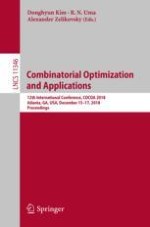2018 | Buch
Combinatorial Optimization and Applications
12th International Conference, COCOA 2018, Atlanta, GA, USA, December 15-17, 2018, Proceedings
herausgegeben von: Donghyun Kim, Dr. R. N. Uma, Alexander Zelikovsky
Verlag: Springer International Publishing
Buchreihe : Lecture Notes in Computer Science
